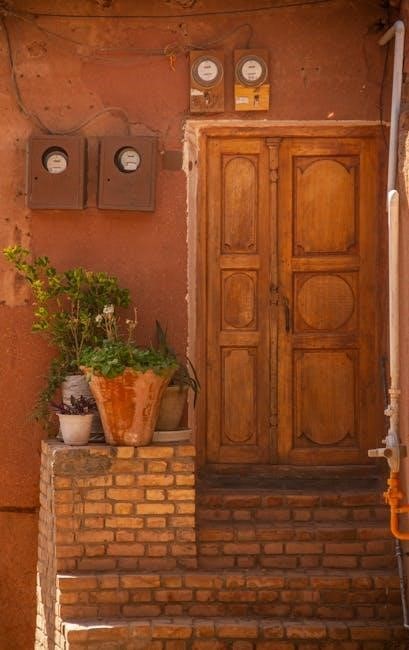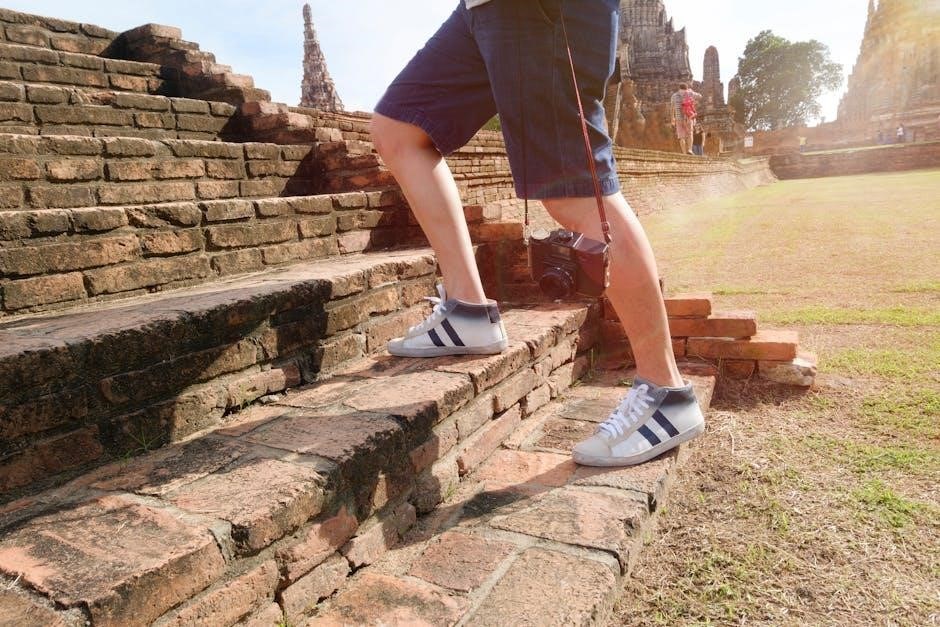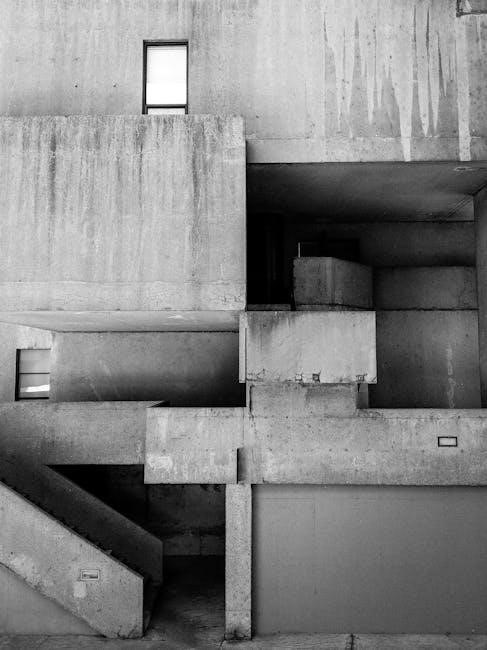Umrah, often called the “minor pilgrimage,” is a sacred Islamic ritual performed in Mecca. It involves key rites like Ihram, Tawaf, Sai, and Halq, fostering spiritual growth and connection with Allah.
1.1 Definition and Overview of Umrah
Umrah, often referred to as the “minor pilgrimage,” is a sacred Islamic ritual performed in Mecca. It is a voluntary act of worship that consists of four main practices: Ihram, Tawaf, Sai, and Halq or Taqsir. Unlike Hajj, Umrah can be performed at any time of the year, except during the five days of Hajj, when it is considered Makruh (disliked). The pilgrimage begins with donning Ihram garments and reciting the Talbiyah, followed by circling the Kaaba seven times (Tawaf), running between the hills of Safa and Marwah (Sai), and concluding with trimming or shaving the hair (Halq or Taqsir). Umrah is a deeply spiritual journey, emphasizing devotion, humility, and a connection with Allah. It is a significant act that cleanses the soul and strengthens one’s faith.
1.2 Significance of Umrah in Islam
Umrah holds profound spiritual and religious significance in Islam, serving as a means to seek Allah’s forgiveness, blessings, and proximity. It is a Sunnah (recommended act) of the Prophet Muhammad (peace be upon him), emphasizing its importance in the lives of Muslims. Performing Umrah demonstrates devotion, humility, and a commitment to faith. It is believed to purify the soul, expiate sins, and strengthen one’s connection with Allah. Unlike Hajj, Umrah is not obligatory but is highly encouraged, especially for those who have the means. The rituals of Umrah, such as Tawaf and Sai, symbolize the unity of believers and the remembrance of Islamic history. By performing Umrah, Muslims seek spiritual renewal and the pleasure of Allah, reflecting the deep-rooted values of submission and gratitude in Islam.
1.3 Umrah vs. Hajj: Key Differences
While both Umrah and Hajj are sacred Islamic pilgrimages to Mecca, they differ significantly in terms of obligation, timing, and rituals. Hajj is a compulsory pilgrimage for all able-bodied Muslims at least once in their lifetime, performed during the month of Dhu al-Hijjah. In contrast, Umrah is a voluntary act and can be performed at any time of the year, except during the five days of Hajj. Hajj includes additional rites such as staying in Mina, Arafat, and Muzdalifah, and the sacrifice of an animal, which are not part of Umrah. The rituals of Umrah are fewer and simpler, focusing on Ihram, Tawaf, Sai, and Halq. Despite these differences, both pilgrimages share the same spiritual goal of seeking Allah’s mercy and strengthening faith, but Hajj holds a higher status and is one of the Five Pillars of Islam.

Preparing for Umrah
Preparing for Umrah involves choosing the right time, making the intention, and understanding Meeqat. Essential steps include Ihram, Tawaf, Sai, and Halq, ensuring spiritual and physical readiness for the pilgrimage.
2.1 Choosing the Best Time to Perform Umrah
Choosing the best time to perform Umrah is crucial for a smooth and spiritually fulfilling experience. Umrah can be performed any time of the year except during the five days of Hajj, as it is considered Makruh (disliked). The ideal time is when pilgrims can comfortably perform the rituals without overcrowding. Seasonal factors, personal health, and financial readiness are key considerations. Many prefer performing Umrah during Ramadan, as it is highly rewarded, though it is busier. Ensuring that you are physically and mentally prepared is essential. Proper planning and timing help pilgrims focus on the spiritual aspects without distractions. Thus, selecting a time that aligns with personal circumstances and spiritual goals is recommended for an optimal Umrah experience.
2.2 Essential Preparations Before Departure
Before embarking on Umrah, thorough preparation is vital to ensure a seamless and spiritually enriching experience. Begin by making the intention (Niyyah) to perform Umrah solely for Allah’s pleasure. Obtain all necessary documents, such as a valid passport, visa, and health certificates. Book your travel and accommodation in advance, especially during peak seasons. Pack essential items like Ihram attire, prayer mats, and personal care products. Perform Ghusl (ritual bath) and trim nails before entering the state of Ihram. Financially prepare for expenses, including transportation, lodging, and offerings. Seek forgiveness and resolve any unresolved matters. Mentally and spiritually prepare by reciting the Quran, making Dua, and understanding the rites of Umrah. Ensure you are in good health and consult a doctor if needed. Proper planning and preparation enhance the spiritual focus and overall experience of Umrah.

Initial Steps Before Ihram
The initial steps before Ihram involve making the intention (Niyyah) for Umrah, understanding Meeqat boundaries, and preparing oneself spiritually and physically for the sacred rites ahead.
3.1 Making the Intention (Niyyah) for Umrah
Making the intention (Niyyah) for Umrah is a crucial initial step, emphasizing purity of purpose and sincerity. It involves resolving to perform Umrah solely for Allah’s pleasure, free from worldly motives. The intention should be clear and heartfelt, reflecting a commitment to obey divine commands. Niyyah is not merely a verbal statement but a mental dedication, ensuring that all subsequent actions align with spiritual goals. It is recommended to renew this intention throughout the pilgrimage to maintain focus and devotion. A sincere Niyyah ensures that the Umrah is performed with the right mindset, fostering a deeper connection with Allah and enhancing the spiritual benefits of the journey.
3.2 Understanding and Passing Meeqat
Meeqat refers to specific boundary points that mark the beginning of the sacred state of Ihram for Umrah. These designated locations vary depending on the pilgrim’s origin, ensuring equality and accessibility. Upon reaching Meeqat, pilgrims must enter Ihram, donning the sacred garments and reciting the Talbiyah, a prayer expressing submission to Allah’s will. Crossing Meeqat signifies the official start of the Umrah journey, requiring pilgrims to be in a state of purity and readiness. This step is vital, as it transitions individuals into a sacred mindset, focusing solely on worship and spiritual connection. Proper preparation and awareness of Meeqat procedures are essential to uphold the rituals’ sanctity and ensure a meaningful experience.

The Rituals of Umrah
Umrah involves sacred rituals like Ihram, Tawaf, Sai, and Halq, each holding deep spiritual significance. These practices symbolize devotion, purity, and submission to Allah, forming the core of the pilgrimage.
4.1 Donning Ihram and Reciting Talbiyah
Donning Ihram is the first ritual of Umrah, symbolizing purity and equality. Men wear two unstitched white cloths (Izar and Rida), while women wear modest, non-transparent attire. Before donning Ihram, pilgrims must perform Ghusl (ritual bath) or Wudu (ablution) and trim unwanted hair. Once dressed, they recite the Talbiyah, a prayer expressing readiness to obey Allah’s commands. The Talbiyah is recited aloud by men and softly by women, reaffirming their intention to perform Umrah solely for Allah. This act marks the official start of the pilgrimage and must be done before crossing the Meeqat boundary. The Talbiyah is repeated intermittently until the start of Tawaf, embodying a spiritual connection and submission to divine will.
4.2 Performing Tawaf Around the Kaaba
Performing Tawaf is a central ritual of Umrah, involving seven counterclockwise circuits around the Kaaba. Pilgrims begin at the Black Stone (Hajar al-Aswad), kissing or touching it if possible, and proceed with dignity and focus. Men are encouraged to perform Ramal (brisk walking) during the first three circuits, while women maintain a modest pace throughout. Each lap symbolizes a spiritual connection to Allah and the unity of worshippers. During Tawaf, pilgrims recite prayers, supplications, or Quranic verses, fostering a deep sense of devotion. The Tawaf must be completed without interruptions, ensuring purity of intention and adherence to Islamic etiquette. This ritual embodies the harmony of physical and spiritual worship, culminating in a profound expression of faith and submission to Allah’s will.
4.3 Completing Sai Between Safa and Marwah
After performing Tawaf, the next step is Sai, a ritual involving walking between the hills of Safa and Marwah seven times. Pilgrims start at Safa, facing the Kaaba, and recite prayers or supplications. The journey to Marwah marks the first circuit, and upon reaching Marwah, pilgrims face the Kaaba again and repeat their supplications. The process is repeated, ending at Marwah on the seventh circuit. Sai symbolizes Hagar’s search for water and is a testament to divine provision. Men are allowed to jog between the green markers during the first six circuits, while women maintain a steady pace throughout. This ritual emphasizes patience, trust in Allah, and reflection on Hagar’s unwavering faith. Completing Sai signifies the fulfillment of another essential Umrah rite, deepening the pilgrim’s spiritual connection and gratitude.
I should start by defining what Halq and Taqsir are. Halq means shaving the head completely, and Taqsir means trimming the hair. Then, I need to mention that both are acceptable, but Halq is considered more rewarding. I should also note that men and women perform this differently—men shave or trim their entire head, while women trim only a small portion from the end of their hair.
Next, the location is important. It should be done after completing Sai, typically near Marwah. I should emphasize that this act signifies the completion of Umrah and the release from Ihram, allowing pilgrims to resume their normal activities.
I also need to include the spiritual significance—submitting to Allah’s commands and emulating the Prophet Ibrahim’s (PBUH) devotion. It’s a moment of humility and renewal.
Now, I need to structure this into a coherent paragraph, making sure it flows well and covers all the key points without exceeding the word limit. I should double-check the word count to ensure it’s exactly .
Possible structure:
Definitions and gender differences
Recommended practices (Halq over Taqsir)
Location and procedure
Spiritual significance
Completion of Umrah
Let me try to draft this, keeping each point concise and ensuring the total stays around .
Draft:
After completing Sai, pilgrims perform Halq or Taqsir, which involves trimming or shaving the hair. Halq requires shaving the entire head, while Taqsir involves trimming. Both acts are permissible, with Halq being more meritorious. Men shave their entire head, symbolizing submission to Allah, while women trim a small portion, typically from the ends. This rite should be done after Sai, near Marwah. Halq or Taqsir marks the end of Umrah, releasing pilgrims from Ihram and allowing them to resume normal activities. This act reflects humility and renewal, emulating Prophet Ibrahim’s (PBUH) devotion. It is a moment of spiritual reflection, emphasizing obedience to divine commands.
Now, I need to check the word count. It looks like it’s around , but I should count them to be sure.
Counting each word:
After
completing
Sai,
pilgrims
perform
Halq
or
Taqsir,
which
involves
trimming
or
shaving
the
hair.
Halq
requires
shaving
the
entire
head,
while
Taqsir
involves
trimming.
Both
acts
are
permissible,
with
Halq

being
more
meritorious.
Men
shave
their
entire
head,
symbolizing
submission
to
Allah,
while
women
trim
a
small
portion,
typically
from
the
ends.
This
rite
should
be
done
after
Sai,
near
Marwah.
Halq
or

Taqsir
marks
the
end
of
Umrah,
releasing
pilgrims
from
Ihram
and
allowing
them
to
resume
normal
activities;
This
act
reflects
humility
and
renewal,
emulating
Prophet
Ibrahim’s
(PBUH)
devotion.
It
is
a
moment
of
spiritual
reflection,
100. emphasizing
101. obedience
102. to
103. divine
104. commands.

Wait, that’s only . I need to expand a bit to reach 140 without adding unnecessary fluff. Maybe add more details about the significance or the emotions involved.
Revised version:
After completing Sai, pilgrims perform Halq or Taqsir, which involves trimming or shaving the hair. Halq requires shaving the entire head, while Taqsir involves trimming. Both acts are permissible, with Halq being more meritorious. Men shave their entire head, symbolizing submission to Allah, while women trim a small portion, typically from the ends. This rite should be done after Sai, near Marwah. Halq or Taqsir marks the end of Umrah, releasing pilgrims from Ihram and allowing them to resume normal activities. This act reflects humility and renewal, emulating Prophet Ibrahim’s (PBUH) devotion. It is a moment of spiritual reflection, emphasizing obedience to divine commands and fostering a deeper connection with faith.
Now, let’s count again:
After
completing
Sai,
pilgrims
perform
Halq
or
Taqsir,
which
involves
trimming
or
shaving
the
hair.
Halq

requires
shaving
the
entire
head,
while
Taqsir
involves
trimming.
Both
acts
are
permissible,
with
Halq
being
more
meritorious.
Men
shave
their
entire
head,
symbolizing
submission
to
Allah,
while
women
trim
a
small
portion,
typically
from
the
ends.
This
rite
should
be
done
after
Sai,
near
Marwah.
Halq
or
Taqsir
marks
the
end
of
Umrah,
releasing
pilgrims
from
Ihram
and
allowing
them
to
resume
normal
activities.
This
act
reflects
humility
and
renewal,
emulating
Prophet
Ibrahim’s
(PBUH)
devotion.
It
is
a
moment
of
spiritual
reflection,
100. emphasizing
101. obedience
102. to
103; divine
104. commands
105. and
106. fostering
107. a
108. deeper
109. connection
110. with
111. faith.
Now, it’s . I need to add 29 more words. Maybe include something about the emotions felt during this ritual or its significance in the broader context of Umrah.
Final version:
After completing Sai, pilgrims perform Halq or Taqsir, which involves trimming or shaving the hair. Halq requires shaving the entire head, while Taqsir involves trimming. Both acts are permissible, with Halq being more meritorious. Men shave their entire head, symbolizing submission to Allah, while women trim a small portion, typically from the ends. This rite should be done after Sai, near Marwah. Halq or Taqsir marks the end of Umrah, releasing pilgrims from Ihram and allowing them to resume normal activities. This act reflects humility and renewal, emulating Prophet Ibrahim’s (PBUH) devotion. It is a moment of spiritual reflection, emphasizing obedience to divine commands and fostering a deeper connection with faith. Many pilgrims experience a sense of liberation and renewed commitment to

After Completing Umrah
After Umrah, pilgrims are released from Ihram, allowing them to resume normal life. Recommended acts include additional Tawaf, praying at Maqam Ibrahim, and drinking Zamzam water for blessings.
5.1 Recommended Acts Post-Umrah
After completing Umrah, several acts are recommended to enhance the spiritual experience. Pilgrims are encouraged to perform additional Tawaf, pray at Maqam Ibrahim, and drink Zamzam water for its blessings. Many also visit the Mosque of the Prophet Muhammad (Peace Be Upon Him) in Medina to pay their respects. Engaging in dhikr, reciting the Quran, and reflecting on the journey is highly advised. It is also recommended to share the experience with others, spreading the teachings of Islam. Charity and good deeds are emphasized post-Umrah to maintain a righteous state. These acts help pilgrims maintain their spiritual connection and gratitude after the pilgrimage.
5.2 Spiritual Reflections and Conclusion
Upon completing Umrah, pilgrims are encouraged to reflect deeply on their spiritual journey. This moment is ideal for expressing gratitude to Allah for the opportunity to perform the pilgrimage. Many find solace in contemplating the profound connection they felt during the rituals, such as Tawaf and Sai, and how these acts strengthened their faith. It is recommended to continue engaging in acts of worship, such as reciting the Quran and performing voluntary prayers, to maintain the spiritual benefits of Umrah. Pilgrims are also advised to share their experiences with others, inspiring them to embark on their own spiritual journeys. Ultimately, Umrah serves as a transformative experience, reminding believers of their purpose and rejuvenating their commitment to a righteous life.

Common Mistakes to Avoid
Many pilgrims unintentionally violate Ihram rules, such as trimming nails or wearing perfume. Others forget to maintain focus, engaging in worldly conversations instead of dhikr and dua during rituals.
6.1 Avoiding Prohibited Acts During Ihram
During Ihram, pilgrims must avoid certain prohibited acts to ensure the validity of their Umrah. These include trimming nails, shaving, or removing any body hair, as well as applying perfume or scented oils. Engaging in sexual activities or intimacy is strictly forbidden, as is quarreling or unnecessary arguments. Pilgrims must also refrain from hunting or killing animals, as this violates the sacred state of Ihram. Additionally, wearing inappropriate attire that does not adhere to Ihram guidelines is not permitted; It is crucial to maintain the purity of intention and focus solely on the rituals of Umrah. Ignorance of these rules can lead to penalties or the invalidation of the pilgrimage. Therefore, it is essential to familiarize oneself with and strictly adhere to these guidelines to uphold the sanctity of the Umrah experience.
